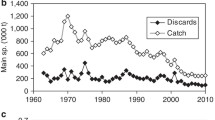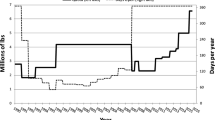Abstract
Previous literature has shown that when there is a deterministic relationship between abatement choices and outcomes, policies with penalty threats can be designed to induce polluting firms to undertake efficient abatement measures voluntarily. We develop a game theoretic model to investigate whether a similar policy can be designed and applied to reduce stochastic bycatch. The policy design would involve a penalty threat that would induce fishers to undertake efficient avoidance measures voluntarily to reduce interactions between fishing vessels and bycatch species. Our findings indicate that both individual and group performance standards (a threshold of allowable bycatch mortalities per fishing season) can be designed such that the penalty threat is sufficient in inducing risk-neutral agents to undertake the first-best level of avoidance activity voluntarily. The optimal threshold depends on the degree of variability in the bycatch level and the discount factor. The net impact of environmental uncertainty on the optimal threshold is ambiguous and depends on the underlying distribution of bycatch mortalities, given the efficient level of avoidance measures. The paper identifies and emphasizes the information requirements that arise when environmental policies involving penalty threats are applied to mitigate stochastic externalities by inducement of efficient (voluntary) abatement behavior.

Similar content being viewed by others
Notes
In the context of conservation policies, US regulatory agencies have usually adopted ‘carrot’ approaches that provide some form of benefit to the agents in exchange for undertaking voluntary conservation measures. Benefits have been in the form of tax credits, subsidies and cost sharing schemes. An example of a voluntary conservation program involving a carrot approach is the Private Stewardship Grants Program, which is administered by the US Fish and Wild Life Service and which provides federal grants on a competitive basis to landowners engaged in conservation of endangered species on private land.
Other authors, such as Cochard and Xepapadeas (2005), show that when both the threshold limit and the group fine are set at a significantly high level and when there is communication among players even before the policy is put into effect, the group fine is more effective in inducing an efficient outcome. Vossler et al. (2006) evaluate the relative effectiveness of ambient mechanisms in a nonpoint pollution context and find that group communication increased the efficacy of mechanisms that involve fixed fines, but resulted in inefficiency in the context of the tax-subsidy instrument.
These activities could include using devices specifically designed to avoid interactions, fishing in different location to avoid turtles, or fishing at a different time in the day or season. This is analogous to abatement measures undertaken by polluting firms.
The cost of sorting (and discarding) the bycatch species from the target species can be significant in case of smaller bycatch species like finfish, and may play a role in the fisher's harvesting decisions (see Herrera, 2005). However, given our focus is on large (easily identifiable) non-marketable species such as sea turtles, for simplicity, we assumed this cost to be zero. We can assume a fixed cost of discarding sea turtles. However, it will not have any impact on the results of this model.
The policy is intended to be solely an externality correcting mechanism, and not a revenue generating device for the government (represented by the regulator).
In practice, both the number of trips and the length of a trip may vary depending on a number of factors, like the weather and water condition. For example, in the context of Gulf of Mexico shrimp fisheries, the length of the fishing trip typically ranges from a single day to a couple of weeks. However, for our purpose, we assume that both the length of a trip and the number of trips are fixed and equal for all fishers. Also, we assume that the fisher makes his avoidance decision at the beginning of the season and sticks with the same decision throughout the season. We understand that this may not be always true in reality and that the fisher may adjust his initial decision based on current conditions. For example, if his trawler interacted with too many turtles or dolphins yesterday, the fisher might choose a higher a today. However, for simplicity, we abstract from this consideration.
Given our assumption of identical fishers, for the sake of convenience we drop the subscript i
See Horan et al. (1998) for a detailed discussion of this issue.
In a world without uncertainty regarding bycatch, the socially optimal level of avoidance activity would ensure that the fisher does not exceed the standard. Hence, the fisher's choice set is reduced to only two choices \(\begin{aligned} (0,a*) \end{aligned}\).
Even with uncertainty, this adjustment would not be required if the policy involved a symmetric payment scheme such as a tax-subsidy policy. Under the current policy, the fisher is penalized (by permanently entering the tax stage) if he fails to meet the target in the initial voluntary period. The asymmetric nature of the payment scheme implies that the benefits of being at or below the threshold in the voluntary period come from only reducing the probability of incurring future tax payments and not from receiving some expected subsidy payments for meeting the target.
We acknowledge that in reality the bycatch levels of individual fishers may be dependent on each other, for example, because of common fishing location. In that case, the particular nature of dependency will play a role in determining the efficiency properties of the group policy. However, for simplicity, in this paper we assume away any form of interdependence among the fishers' bycatch levels.
References
Abbott J, Wilen J (2009) Regulation of fisheries bycatch with common-pool output quotas. J Environ Econ Manag 57(2):195–204
Baumol WJ, Oates WE (1988) The theory of environmental policy. Cambridge University Press, Cambridge
Bisack KD, Sutinen JG (2008) Harbor porpoise bycatch: ITQs or time/area closures in the New England gillnet fishery. Land Econ 82(1):85–102
Boyce JR (1996) An economic analysis of the fisheries bycatch problem. J Environ Econ Manag 31(3):314–336
Cason TN, Mui V (2005) Uncertainty and resistance to reform in laboratory participation games. Eur J Polit Econ 21(3):708–737
Cochard W, Xepapadeas A (2005) Efficiency of nonpoint source pollution instruments: an experimental study. Environ Resour Econ 30(4):393–422
Dixit A, Olson M (2000) Does voluntary participation undermine the Coase Theorem? J Public Econ 76(3):309–335
Hansen L (1998) A damage based tax mechanism for regulation of non-point emissions. Environ Resour Econ 12(1):99–112
Hennessy DA, Feng H (2008) When should uncertain nonpoint emissions be penalized in a trading program? Am J Agric Econ 90(1):249–255
Herrera GE (2005) Stochastic bycatch, informational asymmetry, and discarding. J Environ Econ Manag 49(3):463–483
Hicks RL, Schnier KE (2008) Eco-labeling and dolphin avoidance: a dynamic model of tuna fishing in the Eastern Tropical Pacific. J Environ Econ Manag 56(2):103–116
Horan RD, Shortle JS, Abler DG (1998) Ambient taxes when polluters have multiple choices. J Environ Econ Manag 36(2):186–199
Langpap C, Wu J (2004) Voluntary conservation of endangered species: when does no regulatory assurance mean no conservation? J Environ Econ Manag 47(3):435–457
Mrozek JR, Keeler AG (2004) Pooling of uncertainty: enforcing tradable permits regulation when emissions are stochastic. Environ Resour Econ 29(4):451–481
Parkhust GM, Shogren JF (2003) Evaluating incentive mechanisms for conserving habitat. Nat Resour J 43(4):1093–1149
Segerson K. (2007) Reducing stochastic sea turtle bycatch: an efficiency analysis of alternative policies. Working paper, Department of Economics, University of Connecticut, Storrs
Segerson K, Wu J (2006) Nonpoint source pollution control: inducing first best outcomes through the use of threats. J Environ Econ Manag 51(2):165–184
Smith RBW, Shogren J (2002) Voluntary incentive design for endangered species protection. J Environ Econ Manag 43(2):169–187
Spraggon J (2002) Exogenous targeting instruments as a solution to group moral hazards. J Public Econ 84(3):427–456
Suter JF, Segerson K, Vossler CA, Poe GL (2010) Voluntary-threat approaches to reduce ambient water pollution. Am J Agric Econ 92(4):1195–1213
Teisl MF, Roe B, Hicks RL (2002) Can eco-labels tune a market? evidence from dolphin-safe labeling. J Environ Econ Manag 43(3):339–359
Vossler CA, Poe GL, Schulze WD, Segerson K (2006) Communication and incentive mechanisms based on group performance: an experimental study of nonpoint pollution control. Econ Inq 44(4):599–613
Yates AJ, Cronshaw MB (2001) Pollution permit markets with intertemporal trading and asymmetric information. J Environ Econ Manag 42(1):104–118
Acknowledgments
The author is deeply grateful to Kathleen Segerson for her comments on earlier drafts of this paper. In addition, the author would like to thank two anonymous referees of this journal and participants at the 2011 EAERE Summer School in Venice, Italy, and 2013 EAERE Conference in Toulouse, France, for their comments. Any remaining errors are the responsibility of the author.
Author information
Authors and Affiliations
Corresponding author
Appendix
Appendix
Statement Some free-riding can exist even when the target is met voluntarily
Proof When \(a_{jv}\) = 0, there are four possible cases corresponding to the choice of \(a_{iv}\):
Given \(X = \bar{X}\), \(\rho^{**} = d\) and \(a_{jv}^{*} = 0\), what is fisher \(i\)’s best response in the voluntary stage?
Note that if \(\frac{{\partial F(\bar{X})}}{\partial a} > 0\) and \(a^{*} > 0\), \(F(\bar{X}^{**} ,a^{*} ,0) > F(\bar{X}^{**} ,0,0)\) \(\forall a\)
Because \(c(a^{*} ) > c(0)\) and \(y(a^{*} ) \ge or \le y(0)\).
\(\pi (a^{*} ) \ge or \le \pi (0)\),
when \(a_{jv}^{*} = 0,\) there are four possible cases corresponding to the choice of \(a_{iv}^{*}\):
-
(1)
\(a_{iv}^{*} = 0\),
-
(2)
\(a_{iv}^{*} \in (0,a^{*} )\),
-
(3)
\(a_{iv}^{*} = a^{*}\),
-
(4)
\(a_{iv}^{*} > a^{*}\).
When \(a_{jv}^{*} = 0\), fisher will set \(a_{iv}^{*} = a^{*}\) iff \(V(a^{*} ,0) > V(a_{v} ,0)\), where \(a^{*} \ne a_{v}\), or
The above expression simplifies to:
Since either terms in the above expression cannot be signed, we cannot claim \(V(a^{*} ,0) > V(a_{v} ,0)\) will hold true for all values of \(a_{iv}\). Thus, the incentives to free ride in equilibrium are not eliminated with these parameter choices. If all firms choose 0 or any \(a < a^{*}\) in the voluntary stage, the target will be met only by pure chance.
About this article
Cite this article
Mukherjee, Z. Controlling stochastic externalities with penalty threats: the case of bycatch. Environ Econ Policy Stud 18, 93–113 (2016). https://doi.org/10.1007/s10018-015-0113-6
Received:
Accepted:
Published:
Issue Date:
DOI: https://doi.org/10.1007/s10018-015-0113-6




